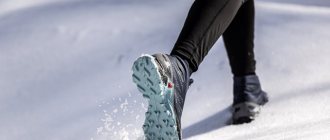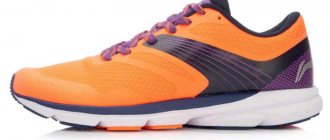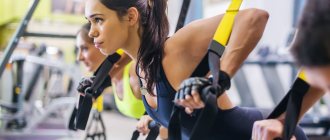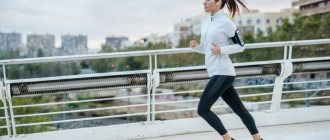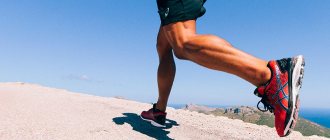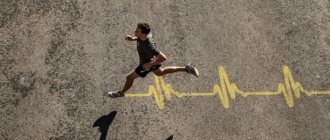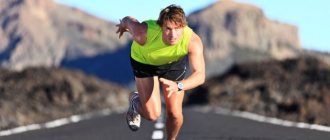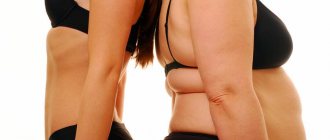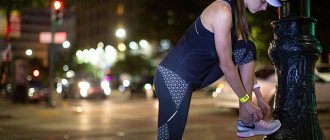October is a month that brings cold weather, wind and puddles on the roads. But cool weather is no reason to stop running outdoors. It is possible and even necessary to continue to stay in shape in this way; it is only important to choose the right equipment so as not to catch a cold. So what things do we need for a run if the thermometer shows below +10℃?
There are two main principles
, which should guide you when choosing autumn equipment.
First, you need to dress in layers so that each of them performs its function: retaining heat, removing moisture, or protecting from wind and precipitation. Second, don't wear too much clothing to avoid overheating. At first, you may think that dressing as warmly as possible will make you feel comfortable. But at the peak of the run, the body will overheat, begin to sweat heavily, you will feel hot - the chances of catching a cold double. Some experienced runners even advise following the ten-degree rule. According to this principle, you should prepare for a run as if the outside air temperature is 10 degrees higher than it actually is.
We tell you what pieces of equipment include layers and what functions they perform.
Photo: istockphoto.com
First layer
At temperatures below +10℃, we recommend putting aside the summer set consisting of a T-shirt with shorts, and using long sleeves and tights as the first layer. They should be made of elastic, lightweight, breathable materials, such as sports synthetics. It is important that this part of the equipment fits the body, but does not restrict movement.
By the way, if for aesthetic reasons you are uncomfortable running in tights alone, then you can wear running shorts over them. They will not only relieve you from embarrassment, but will also serve as additional insulation.
For those who like to run in frosty weather, we advise you to think about insulated tights. They can usually be distinguished by a dense insert on the front surface of the leg. If necessary, you can wear thermal underwear underneath.
Spring running rules
Running in the spring has one disadvantage - the weather is still changeable, and there are puddles and mud on the roads. To make training more comfortable, you should adhere to several rules.
- Dress as if it were 10 degrees warmer outside. This way you won't sweat or freeze.
- Wear several layers of clothing. Morning frosts can be replaced by heat by the middle of the workout. To avoid overheating, remove clothing as the weather warms up.
- Don't be afraid to get wet in the rain. Properly selected equipment will prevent you from catching a cold.
- Run around puddles rather than jump over them. It is quite possible that in early spring there is still ice on the puddles, and you may slip or end up in the water without calculating the force of your jump. Try to build running routes on dry sidewalks.
Third layer
This layer serves as protection from wind and precipitation. Clothing chosen as a third layer should be breathable and not retain moisture in order to allow things underneath to dry.
If the air temperature is in the range from +5℃ to +10℃, then the appropriate piece of equipment for you is a light windbreaker that can be worn over a long sleeve. In case of noticeable cold weather, we recommend purchasing more reliable protection - a windstopper jacket, it should be worn with fleece. The main feature of winstoppers is the presence of a special membrane, thanks to which air from the street is not allowed into the body, but steam from inside can freely leak out.
When you feel like your legs need some insulation too, include windproof pants in your running kit. They are made of lightweight fabric that will protect against moisture in rainy, windy and even snowy weather.
What should I wear?
During winter jogging, considerable demands must be placed on shoes. In our weather conditions this is especially important - in winter the roads turn into either mush or a “skating rink”. So, what should a runner wear to avoid slipping and getting his feet wet?
The nuances when choosing winter running shoes are as follows:
- Protection from getting wet. Shoes should be made of water-repellent materials, preferably with a membrane that does not allow moisture to pass through.
- Corrugated elastic sole (with spikes or sharp tread). The sole should be soft and well-cushioned, but not freeze at low temperatures.
- Light weight.
- Protection from cold. Shoes should be insulated with natural or artificial fur, so you can safely put your summer sneakers in the closet for “wintering.”
- Replaceable insoles that are easy to remove and dry.
- High boot and tongue, tight lacing.
- No mesh inserts.
Returning to a warm room after finishing your workout, you should immediately take off your wet clothes and take a shower.
So, we are convinced that you can run comfortably and profitably at any time of the year and in any weather conditions. Well, or almost any kind - in severe frosts, below -25°C, only well-trained athletes can run. Beginners run the risk of catching a cold in their respiratory system and getting complications.
But with frosts down to -15 °C, you can easily go for a run. Properly selected equipment will help you get ready for training and easily cover the required distance.
How and where to run in winter, and whether to run at all, is something everyone decides for themselves. Of course, training will be more comfortable in the gym or at home on a treadmill. But if you're an outdoor enthusiast, we hope the coming winter won't be a stumbling block to your running and you'll discover a whole new side of running! The main thing is not to give up and continue your activities and always stay in great shape!
Useful accessories
In addition to basic clothing, it is worth paying attention to additional accessories that will make your autumn run even warmer. Among the useful pieces of equipment, we are ready to recommend the following.
• Socks
. It's time to put aside the summer cropped version and reach for long socks that completely cover the ankle. Some people prefer to wear gaiters or compression socks to provide additional shin protection.
• Gloves
. High-quality running gloves not only provide insulation, but also protect from the wind, as they are equipped with windstopper material. In addition, many models have touch inserts on your fingers so you can easily change the music on your smartphone or answer a call.
• Buff
. This is a bandage that is mainly worn around the neck and insulates the throat. But you can see runners who wear it as a gaiter or a bandana - this is also possible.
• A cap.
It will protect your head from the wind. In addition, a specialized running item will wick moisture away from your hair.
Gloves and hat for running in autumn
A lot of heat is lost through the arms, head and neck. In addition, everyone has their own characteristics of blood circulation: hands can freeze even when the body is hot. This is why marathon runners are dressed strangely for an ordinary person: a T-shirt and shorts, but with gloves and a hat.
Eliud Kipchoge at the London Marathon. Photo: irishmirror.ie
Hat or ear band
In warm weather, ear bands are enough; wearing a hat can be hot. As the weather gets colder, switch to a hat. The material should be synthetic to dry quickly and wick away moisture. There are windproof options for harsher weather.
Running hats and headbands
Gloves
It is better to have 2-3 pairs of gloves for different temperatures. Thin ones may be needed already at about 0°C, and at -10°C choose thicker options, preferably with wind protection. Choose gloves based on the characteristics of your body. Some people are comfortable running down to -10°C without gloves, while others already put on warm gloves at 0°C. Warm models can be selected from cross-country ski gloves.
Neck protection
You can cover your neck from the cold strong wind with the help of a buff. Other names: trumpet, bandana, gator, scarf. For autumn, thin synthetic options are suitable, and for extreme cold, options with fleece insulation are suitable. You can wear a buff around your neck in different ways: like an accordion, in two layers, covering your chin with it, or pulling it over the back of your head when it’s very cold.
Running socks
Running socks may seem like a small thing, but they can cause a lot of trouble. The recommendations are standard for any weather: no cotton. Synthetic socks wick away moisture well and do not cause calluses. For fall, choose tall models that cover your ankles. A cold ankle can lead to problems with the joints and Achilles.
Running socks
Sneakers
The last but not least important thing we will talk about. In general, when autumn does not upset you with frosts, and the air temperature is moderately cool, you can leave the same sneakers that you trained in during the warm season. If it’s freezing outside and you can hardly stand the cold, then sneakers with an insulating membrane will do. The coating will also protect you from unwanted splashes that will not penetrate the shoes.
Another reason to change shoes is a change in the running surface. Although almost all city roads are now paved, there are still lovers of jogging along forest paths and rough terrain among us. In this case, it is better to change your asphalt sneakers to dirt ones. They are equipped with a special sole with a pronounced tread pattern, which makes running safer.
Now you know exactly how to make your autumn jogging at least warm, and at most comfortable and enjoyable. Listen to your personal feelings, warm yourself up and get started, no excuses!
Summer running clothes
Summer is the most suitable comfortable time for running. Warm weather promotes a good mood and lifts spirits. The understanding comes that the weight gained over the winter needs to be lost. The figure has long been demanding that it be put in order.
Basic attributes of equipment in summer:
- socks;
- sneakers;
- shorts;
- t-shirt.
Additional:
- wristband;
- pedometer;
- tools for artificial weight gain (heavy bands, vests).
Socks
When choosing equipment, minimal attention is paid to socks. However, the benefits of the correct choice of such an unpopular attribute can play a decisive role in the result of training.
I remember well the day when I went for a run and came back with five calluses on my toes. The culprit was poor-quality socks, the seam of which rubbed against the middle of the fingers. As a result, my fingers were burning with pain!
When choosing socks, pay attention to their tailoring. Check the heel and toe in place? It is better if the socks are thin and short, which allows the skin to breathe. To avoid unpleasant odor, use a special deodorant.
Sneakers
Good sneakers are worth their weight in gold and choosing them correctly will help you not only train comfortably, but also improve your results. I recommend using sneakers, not sneakers and definitely not ballet flats.
When choosing sneakers, pay attention to their weight; it should not exceed 500 grams. Ideally ~400 grams. Try bending your toe without putting on your shoes. Good sports shoes should allow the toe to bend and unbend easily. Pay attention to the heel, it must be slightly higher than the toe. Try to press on the heel, test it for a spring effect. If it is there, good, if not, it’s better not to take it.
The essence of the spring heel is increased forward movement. If the heel is higher than the toe, promotion is even better! Sneakers do not have a spring effect, and the heel is level with the toe, which is not only less effective, but also leads to knee pain over time due to damage to the knee joints.
Shorts
The choice of shorts can also affect the result in both directions. Proper running shorts should be above the knee so as not to interfere with the forward movement of your hips. It is advisable to have an elastic band or lace to free your hands from catching the shorts. The material doesn't matter much. However, fabric shorts tend to get wet from sweat and become heavier.
T-shirt
The movement of your arms is important when running, so the T-shirt should not interfere with their work. A T-shirt will do. I give preference to a fitted top, but the success of the workout does not depend on this criterion.
Additionally, your equipment can include a wristband, pedometer, and weight bands. It is better to tie a long haircut with a ribbon or make a ponytail.
Does everyone suffer the same?
- Women are thought to have a slight advantage in high humidity environments due to their smaller size and less sweating. In hot, dry climates, running is a little easier for men. You can read more about the results of this study in the article.
- As a rule, the older the runner, the less able to tolerate high temperatures.
- People who sweat a lot cool down more effectively, but are more prone to dehydration.
But in general, heat tolerance is an individual thing and largely depends on acclimatization . On average, it takes the body from 8 days to 2-3 weeks to adapt to heat. But then he comes to his senses, begins to produce more red blood cells that transport oxygen, and running becomes easier.
This is especially noticeable if you move from a hot climate to a cooler one: with the same effort, the pace numbers are pleasantly surprising. So a fall marathon after hot summer training is a good idea.
First runs in Hong Kong, slow and sad. It only got better by the end of the second week
Running technique or how not to fall at the first turn?
A set of movements performed by an athlete during physical activity of any nature and intensity will be more productive if it corresponds to the optimal technique in each specific sport.
Technique is not an empty phrase, because with its help you can significantly improve your results in the duration or speed of your run. Therefore, carefully study this section so as not to fall at the first turn from fatigue.
Head. During a light jog, you are allowed to look around or smile at a person running past. At the same time, you should not lift your head up, because such a maneuver will lead to loss of coordination and increases the chance of falling. The gaze is directed 10-15 meters ahead. With this head tilt, you can easily control the approach of obstacles and look at your feet so as not to trip.
Shoulders and arms. The shoulder girdle should be relaxed while running. Active movements are performed only with the hands according to the pattern: forward-inward and backward outward. The elbow joint is bent at an angle of 90 degrees.
Hands. While jogging, the hands are clenched into a light fist. Do not clench your fists excessively, as this will lead to a loss of excess energy.
Torso. The angle of the torso forward is 7-9 degrees. If you lean further, you may fall, and if you lean back, you may fall again. Avoid movements in the horizontal axis. The shoulders and body should not turn from side to side and resemble a boat rocking on the waves.
Knees. To run as long as possible, you need to minimize knee extension and knee flexion. Try to take short but frequent steps.
Ankle. Be sure to stretch your ankle before running because it is the most injured part of the body among runners.
Foot placement. There are 3 options for placing the foot: on the toe, from heel to toe, on the entire foot. Methods 2 and 3 are suitable for slow running, but it is better to give preference to the latter.
The peculiarity of running technique is that each athlete can modify it based on personal preferences. The above are standard recommendations that are good for beginner athletes.
Tips for runners in hot weather
Does all this mean that summer is a reason to give up working out/move to an air-conditioned gym? Of course not!
However, it is important to follow some rules to stay healthy + productive.
Running time + route
First of all, create optimal conditions for yourself. Instead of looking for an answer to the question: “Is it possible to run in the heat?” — try to minimize this heat!
Download training plans to prepare for the marathon and half marathon.
Start preparing right now!
The hottest period occurs between 11:00 and 16:00. The sun is most active + the air is warmed up + it is difficult to find shade.
First tip: study early in the morning/evening. The advantage of summer jogging is the long daylight hours!
Second tip: choose a shaded route. It is advisable that the run take place along a dirt path in a forested area. Asphalt, buildings, cars - all urban elements strongly absorb heat + heat the air.
How to drink water correctly?
Most problems are related to fluid loss.
An important note for everyone who uses running in the heat to lose weight: do not rush to rejoice when you see minus 2 kg on the scales after several workouts. You don't lose fat, you lose water. It is extremely dangerous for overweight people to exercise at high temperatures + it is recommended to run in well-ventilated gyms.
How to drink correctly to avoid dehydration?
Liquid volume
Before training, sports experts recommend drinking a liter of water 1-1.5 hours + 250 ml immediately before the start. Recommended fluid volume during training: 400-800 ml/hour.
It is better to calculate your water needs individually. To do this, weigh yourself before + after training, count the difference. This will be your loss of water, which is important to replenish.
The human body is able to consume water up to 1 l/hour.
Remember about microelements! It is better to drink isotonic drinks. If you are prone to cramps, add 0.7 g sodium per liter of water drunk.
Methods of consumption
If your workout is on a circuit course, leave a water bottle in a certain place so you can return to it at regular intervals.
If the route is straight, use belts, pockets for drinking containers, backpacks equipped with a drinking system (suitable for trail running).
Equipment
Is it possible to run in the heat using any indoor clothing? Highly undesirable. In summer there are special equipment requirements.
Cloth
- Clothes should be light-colored to reflect the sun's rays. Dark things absorb them, causing the body to overheat;
- It is better to choose lightweight synthetic fabric (including socks) that will allow moisture to pass through;
- It’s good if clothes have cutouts, mesh, and open areas. However, running without a shirt is a bad idea. Water will evaporate, and sweat salts will clog pores;
- Make sure you wear sportswear that prevents chafing.
Headdress
- Use a cap, sugar, bandana, Panama hat;
- Avoid visors that leave the crown of your head exposed;
- The color of the headdress is light;
- A useful technique is to wet the headdress with cold water.
Accessories
- Sunglasses will help you get through your workout/race without discomfort;
- A heart rate monitor will allow you to monitor your pulse, assessing the state of your body.
Shoes
- Running in hot weather leads to slight swelling and a “steaming” effect of the feet. Rule for choosing sneakers for the summer: shoes should be 0.5-1 size larger than usual;
- For better ventilation, choose sneakers with mesh uppers.
Sunscreen
- SPF more than 50;
- Water resistance (so it won’t wash off later);
- Contains: titanium dioxide + zinc.
CARE OF RUNNING CLOTHES
Regardless of the percentage of synthetic, artificial and (or) natural fibers, sports jersey needs to be properly washed and stored. Each product has its own characteristics. Therefore, following the recommendations indicated on the label will extend the life of the item.
Among the general rules, we note the following:
- Can be washed manually or automatically, in warm water no higher than 40 °C.
- After washing and rinsing with triggers, it is advisable to wring out the item without twisting it.
- Wash in a washing machine in the “Delicate wash without spin” mode.
- Use only mild detergents, no bleaches, conditioners or stain removers.
- Wash compression garments by first turning them inside out.
- Things should be dried flat on a horizontal surface in a well-ventilated area.
- It is not recommended to store seasonal sports items on hangers for a long time; it is better on a shelf.
- Do not iron compression clothing. Ordinary elastic - you can, from the wrong side, with steaming and using moderate temperature.
- Products made from mixed fabric (synthetic + six) may develop pilling over time. They can be removed with a special machine. This must be done by carefully straightening the fabric so as not to damage it.
To summarize, we can say that you can and should run at any time of the year! This charges the soul with a good mood, strengthens the body and willpower. Dress smart and run healthy!
Motivation is already half the battle!
Desire gives rise to dreams and goals, and the latter, with the right approach, become reality. To make your dream come true, you need to make the necessary efforts and do it right. Agree that every effort should be purposeful and then hours of jogging will immediately bring benefits.
In my opinion, the right motivation is half of all success, because without it a person will not be able to make his dream come true. Athletes achieve excellence through rigorous daily training, but what motivates them to do it? What made you take up sports? Everyone has their own argument, which can become the strongest motivation.
It often happens that the goal is not achieved on the first try. Surely many have tried to start running and do it regularly for years. And usually after 1-2 runs, attempts to change my life ended. A year later the attempt was repeated, but again without success.
An important question: why does a person quit exercising after two runs? Probably because no changes have occurred. To achieve the desired result and look like a beautiful athlete or an athletic guy, it takes a lot of time, 1 or 2.3 years.
This is long and requires regular training, but let's look at the situation from the other side! Let's return to the unsuccessful attempts that are made every year. Here's one try, a second, a third. 3 years have already passed. Think about it, after all, in the time it takes you to gather your strength, it is already possible to make your dream come true! Already now you could be the slim person you have been dreaming of for the last few years.
So maybe it's time to really do sports, and not pretend to try? If you agree, then read on about choosing equipment and shoes.
Which jogging is best for weight loss?
Agree that you can run in different ways: show maximum speed from the start and slow down after 400 meters, or gradually pick up speed and run 2,3,5 or 10 kilometers. Let's figure out which option is better for losing weight and, therefore, what kind of jogging intensity we need.
Scientists have concluded that the greatest number of calories are burned when running at high intensity and with an extremely high heart rate. This type of running can burn up to 1,500 calories per hour. However, scientists have not specified who is able to run for an hour at this pace. I suppose that Mohammed Farah could, but he does not suffer from problems with his figure.
The results of another study will be our salvation! According to the conclusion of specialists who conducted the experiment at lower speeds:
- Jogging can burn up to 600 calories in an hour
- Cross running at the same intensity up to 900 calories for the same time.
It's no secret that running 60 minutes at a slow pace is much easier than maintaining maximum speed for the same period of time. And let the sprint with its 1500 calories per hour stand aside while we slowly but surely run towards our goal.
How to breathe correctly while running
A few words about breathing. There are two opinions. The first is that you need to breathe through your nose, the second - through your mouth. The arguments for the first method are as follows: the lungs are trained better, since the work of providing air to the body through narrow nasal openings is harder, the oral mucosa does not dry out, and the loss of moisture in the body is reduced. There is only one argument for mouth breathing - running takes place in conditions of insufficient air supply, so breathing through the mouth is mandatory to fully supply the body with oxygen. At first I breathed through my nose, then switched to breathing through my mouth. The argument in favor of this method seemed more convincing to me. How best to breathe - decide for yourself based on your condition. Many people have difficulty breathing through their nose due to deviated septums or other diseases, and it is simply difficult for them to breathe intensively through their nose; the body does not have enough air.
Along with running, I quit smoking and reduced my alcohol consumption to a minimum. Nicotine and alcohol are completely incompatible with running. If the effects of cigarettes are not so noticeable, then after drinking alcohol the body’s condition worsens sharply. You can clearly see the full extent of the harm from alcohol by playing sports. The result drops very significantly. After about a week, after a little drinking, I recovered and returned to my previous results.
